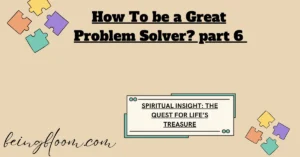
Step 1: Recognize the Issue
The first thing you need to do before you can find what you’re looking for is to search for the key. But instead of searching for treasure, we are looking for understanding and answers. To really get to the heart of the issue, you need to figure out what it is. What is bothering you? Is it in your mind or is it a physical thing? Is it real or just something you’re imagining? Is it even a real problem? As you go through this process, think like a detective.
Figuring out a problem is a lot like using First Principles thinking. Let’s break down what “First Principle” thinking is—because it’s the secret to finding great solutions. Tesla serves as a perfect example. While everyone else was sticking to old ways of creating electric devices, Tesla wondered, “Is there a different way to do this? ” That question led him to invent the AC motor, which is what powers many of our modern gadgets today.
So, First Principle thinking is about getting to the heart of a problem by questioning the basic ideas and then creating something new from that viewpoint. In simple terms, First Principle means to dig deep, challenge assumptions, and start building from the ground up.
Put the Problem on Paper: Don’t try to solve your problems just by thinking about them. Many people have the bad habit of trying to figure everything out in their heads, which often leads to no real solution or, even worse, looking for the wrong answer. That’s why you should write down your problem. Writing makes your thoughts flow better. By putting your thoughts on paper, the problem becomes clearer to you.
For instance: If your girlfriend leaves you for someone else, you might feel a deep pain in your chest.
What type of problem is this—your girlfriend leaving? Clearly, it’s a mental issue. If it were a physical problem, you probably wouldn’t be alive to feel anything. But this is just a mental struggle. Before your girlfriend came into your life, you were still living; when she was with you, you were alive; and after she left, you are still living. She wasn’t something you needed to survive, like air or water. However, it’s true that you are feeling a lot of pain—and the answer to that pain is something you can find within yourself. By asking the right questions, you have figured out what the real issue is. Recognizing the true problem is your first win.
Be Specific: If you aren’t sure about what your problem is, it’s like trying to hit a target in the dark. Make it more specific. The more precise you are, the easier the solution will become.
Ask the Right Questions: Play the “Five Whys” game. This method involves asking “Why? ” five times to get to the root of the issue. For example, if you’re having problems in your relationship, start with: “Why is there an issue? ” If the answer is “Because we don’t talk to each other,” then ask: “Why don’t we talk? ” Keep digging until you find the main issue.
Step Back for a Moment: There are times when we get too focused on a problem and cannot see it well. It helps to take a break. You could go for a walk, do some yoga, or watch a funny show. When you come back, try to look at the issue with a new perspective. You would be surprised how stepping away for a bit can help you think differently.
In summary: Figuring out a problem is like being a detective, a planner, and sometimes a counselor. By understanding exactly what the problem is, you prepare yourself to find good solutions. So, improve your detective skills!
Step 2: Break Down the Problem
Now that you know what your problem is, it’s time to split it into smaller, easier parts. Think of it like peeling an onion—no tears needed! Let’s figure out a practical way to do this. For example, if your girlfriend broke up with you, break that situation into smaller pieces. Let’s analyze it: What specifically makes her leaving hurt you? Why is it bothering you? Is it because she chose someone else and that bruised your pride? Or do you feel like no other girl will appreciate you anymore, which makes you sad? Or is it worrying about what she’s doing with her new boyfriend that’s driving you nuts? Divide your main issue into as many small parts as you can. The goal is to make each little problem so easy to handle that it feels impossible to fail at them.
Set priorities for your tasks. Not every part is equally important. Some pieces need your immediate focus, while others can wait. It’s like playing a game—start with the toughest levels first. Organize your tasks by their importance. This helps you avoid feeling overwhelmed and keeps you on track.
Create an Action List
Now, to get your problem parts into action, make an action list. Write down the small tasks you figured out and check them off when you finish. Looking at a completed list feels really good—almost like leveling up in a game. Each checkmark gets you closer to solving your problem!
Celebrate Small Wins
Every time you finish a piece, make sure to celebrate every little success! It doesn’t have to be a big event, but you should reward yourself in small ways. Maybe you can enjoy a coffee or take a little break. These little celebrations can brighten your mood and turn solving problems into a fun adventure.So, keep in mind: breaking a problem into smaller pieces is not just about making it easier—it’s also about making the process enjoyable. Each small step you take brings you closer to your goal, and celebrating each little success makes the journey more joyful.
Step 3: Think of Solutions
Alright, now let’s jump into the amazing world of creativity! This is a place where your imagination sparkles, and ideas zoom around like colorful confetti during a New Year’s celebration. Are you ready? Let’s explore how solving problems can be thrilling and enjoyable!
1. Let Your Inner Adventurer Out
First, think of brainstorming as your special playground where you can play freely without any restrictions. To explain this better, let’s revisit the issue with your ex-girlfriend. Yes, the one who chose someone else. Imagine this: perhaps the universe has a plan so that nicer and more wonderful girls can come into your life. Or maybe it happened so you can look at new possibilities. No idea is too odd, and no suggestion is too silly. You can even act like a scientist, coming up with creative solutions to your problem. Challenge yourself to find unique answers, even if they sound unusual. Just remember—every great idea started off as something that sounded “nuts. ”
2. Play the “What If” Game
Engage yourself in a little game: What if… then what? What if you had endless money? What if you could ask Einstein for help? What if aliens showed up and sorted out your issue? Sure, it sounds silly—but this method can lead to creative and unexpected solutions. For instance: What if the girl who left me was the only woman on the planet? What if she had never been a part of my life? What if she decided to return one day? These questions might not have realistic answers, but they can help spark ideas that broaden your thinking.
3. Use the Strength of Group Brainstorming
Invite some friends or colleagues to have a brainstorming session together. The more people you have, the better! Different minds bring fresh ideas. Each person can offer their own viewpoint, which might lead to fantastic solutions. Don’t shy away from messy or wacky ideas—embrace them, because creativity often blooms in the messiness.
4. Visualize Your Ideas with a Map
Use mind maps to arrange the ideas you’ve thought of. Begin with a central idea and let your thoughts branch out. Each branch shows a potential solution or a step to get there. This way of organizing helps you clearly see the possibilities and connections.
5. Jot Down “Strange Ideas”
Write down all the weird—even really weird—ideas you’ve come up with. Appreciate every unusual thought, because sometimes the craziest ones can turn out to be practical solutions. For example, if your team is lacking enthusiasm, one “weird” thought might be to have a dress-up theme day at work. It might sound goofy, but it can create fun, excitement, and togetherness.
Want the full toolkit? The remaining steps are waiting in Part 5 of our Problem-Solving Formula







